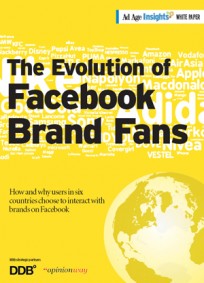















(From the Introduction. The complete report is available for $249 from AdAge.com.)
On July 6, Facebook CEO Mark Zuckerberg took the stage at company headquarters in Palo Alto, Calif., to make the “awesome announcement” that Facebook as we knew it was over. Just as users had experienced the heady rush of racing to replicate their offline relationships in the online world–the “social graph”–and before Facebook had even figured out what to do with them, the site itself had reached a crossroads.
“Social networking is at an inflection point now,” Zuckerberg said, noting the big theme used to be about connecting people. “That’s interesting,” he said, but “that chapter is more or less done at this point.We’re not everywhere yet, but there’s this clear arc where the world generally believes [social software] is going to be everywhere, whether it’s us or somebody else doing it.”
“Driving the narrative for next five years is … what kind of cool stuff and what kind of new social apps you’re going to build now that you have this kind of social infrastructure in place,” he said, not only referring to that day’s announcement of a videocalling linkup with Skype, but also to gaming, messaging, Facebook Places and other features designed to maximize user engagement through stickiness.

This was all in line with has been called Zuckerberg’s Law– the tendency of Facebook users to share twice as much content as the year before. Zuckerberg’s message, in other words: Social media is ubiquitous, we’re all more or less connected, and now it’s about what we do with the social graph. And that’s where marketers come in.
But many have yet to turn the page on the evolution of Facebook into a highly sophisticated communication, engagement and, ultimately, customer relationship management (CRM) tool. They act like the site’s middle-aged users discovering the Pavlovian pleasures of the social graph, spending to acquire fans for their own sake. “When many brands started investing in Facebook, their only metric of success was fan growth, because it was the only thing they could understand,” said Sarah Hofstetter, senior VP-emerging media and brand strategy at 360i.
That has become an increasingly expensive proposition as the cost of advertising on Facebook has skyrocketed and the number of programs has exploded, leading to cutthroat competition for “likes.” Facebook took in $1.86 billion in worldwide advertising revenue in 2010, according to eMarketer, a 151% increase over the company’s estimated 2009 ad revenue of $740 million. Not surprising, a majority of that, $1.21 billion, was generated inside the United States. But by the end of next year, eMarketer expects Facebook’s ad revenue to triple to $5.74 billion–including an even split between domestic and overseas revenue.
For marketers, the question has become, what is the value of a fan? Back-of-the-envelope guesses have ranged from an average of $3.60 (according to a 2010 study by Vitrue, a social-media software provider) to a more reassuring $136.38 (according to Syncapse, a social-media software and services firm). But calculating fans’ value based on such metrics as product spending, brand loyalty and propensity to recommend raises questions of the nonfans because they suddenly like the brand, or were they always more loyal to begin with? And do they organically like the brand, or were they bribed with a promotion, a coupon or an early peek at the web’s next viral video?
There’s only one way to find out, and that is to ask them.
A new survey from DDB Paris, part of DDB Worldwide, and OpinionWay titled “Who Are the Brand Likers?” explores consumer motivations in becoming fans of brands. This is the second study of its kind, following a similar DDB Paris/OpinionWay study last fall, offering an in-depth look at the changing attitudes and habits of Facebook fans and users in the United States, United Kingdom and France–and shedding new light on fans in Germany, Turkey and Malaysia.

» Folllow me on Twitter.
» Email me.
» See upcoming events.

Greg Lindsay is a generalist, urbanist, futurist, and speaker. He is a non-resident senior fellow of the Arizona State University Threatcasting Lab, a non-resident senior fellow of MIT’s Future Urban Collectives Lab, and a non-resident senior fellow of the Atlantic Council’s Scowcroft Strategy Initiative. He was the founding chief communications officer of Climate Alpha and remains a senior advisor. Previously, he was an urban tech fellow at Cornell Tech’s Jacobs Institute, where he explored the implications of AI and augmented reality at urban scale.

----- | January 22, 2024
The Future of Generative AI in Architecture, Engineering, and Construction
----- | January 1, 2024
----- | August 3, 2023
CityLab | June 12, 2023
Augmented Reality Is Coming for Cities
CityLab | April 25, 2023
The Line Is Blurring Between Remote Workers and Tourists
CityLab | December 7, 2021
The Dark Side of 15-Minute Grocery Delivery
Fast Company | June 2021
Why the Great Lakes need to be the center of our climate strategy
Fast Company | March 2020
How to design a smart city that’s built on empowerment–not corporate surveillance
URBAN-X | December 2019
CityLab | December 10, 2018
The State of Play: Connected Mobility in San Francisco, Boston, and Detroit
Harvard Business Review | September 24, 2018
Why Companies Are Creating Their Own Coworking Spaces
CityLab | July 2018
The State of Play: Connected Mobility + U.S. Cities
Medium | May 1, 2017
Fast Company | January 19, 2017
The Collaboration Software That’s Rejuvenating The Young Global Leaders Of Davos
The Guardian | January 13, 2017
What If Uber Kills Public Transport Instead of Cars
Backchannel | January 4, 2017
The Office of the Future Is… an Office
New Cities Foundation | October 2016
Now Arriving: A Connected Mobility Roadmap for Public Transport
Inc. | October 2016
Why Every Business Should Start in a Co-Working Space
Popular Mechanics | May 11, 2016
Can the World’s Worst Traffic Problem Be Solved?
The New Republic | January/February 2016

January 31, 2024
Unfrozen: Domo Arigatou, “Mike 2.0”
January 22, 2024
The Future of Generative AI in Architecture, Engineering, and Construction
January 18, 2024
The Promise and Perils of the Augmented City
January 13, 2024